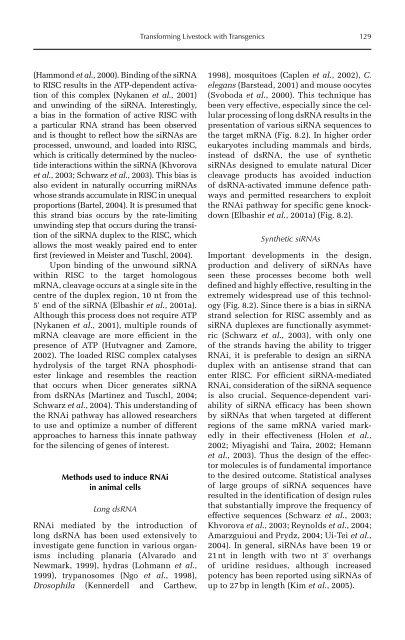Redesigning Animal Agriculture
Redesigning Animal Agriculture
Redesigning Animal Agriculture
You also want an ePaper? Increase the reach of your titles
YUMPU automatically turns print PDFs into web optimized ePapers that Google loves.
(Hammond et al., 2000). Binding of the siRNA<br />
to RISC results in the ATP-dependent activation<br />
of this complex (Nykanen et al., 2001)<br />
and unwinding of the siRNA. Interestingly,<br />
a bias in the formation of active RISC with<br />
a particular RNA strand has been observed<br />
and is thought to reflect how the siRNAs are<br />
processed, unwound, and loaded into RISC,<br />
which is critically determined by the nucleotide<br />
interactions within the siRNA (Khvorova<br />
et al., 2003; Schwarz et al., 2003). This bias is<br />
also evident in naturally occurring miRNAs<br />
whose strands accumulate in RISC in unequal<br />
proportions (Bartel, 2004). It is presumed that<br />
this strand bias occurs by the rate-limiting<br />
unwinding step that occurs during the transition<br />
of the siRNA duplex to the RISC, which<br />
allows the most weakly paired end to enter<br />
first (reviewed in Meister and Tuschl, 2004).<br />
Upon binding of the unwound siRNA<br />
within RISC to the target homologous<br />
mRNA, cleavage occurs at a single site in the<br />
centre of the duplex region, 10 nt from the<br />
5' end of the siRNA (Elbashir et al., 2001a).<br />
Although this process does not require ATP<br />
(Nykanen et al., 2001), multiple rounds of<br />
mRNA cleavage are more efficient in the<br />
presence of ATP (Hutvagner and Zamore,<br />
2002). The loaded RISC complex catalyses<br />
hydrolysis of the target RNA phosphodiester<br />
linkage and resembles the reaction<br />
that occurs when Dicer generates siRNA<br />
from dsRNAs (Martinez and Tuschl, 2004;<br />
Schwarz et al., 2004). This understanding of<br />
the RNAi pathway has allowed researchers<br />
to use and optimize a number of different<br />
approaches to harness this innate pathway<br />
for the silencing of genes of interest.<br />
Methods used to induce RNAi<br />
in animal cells<br />
Long dsRNA<br />
RNAi mediated by the introduction of<br />
long dsRNA has been used extensively to<br />
investigate gene function in various organisms<br />
including planaria (Alvarado and<br />
Newmark, 1999), hydras (Lohmann et al.,<br />
1999), trypanosomes (Ngo et al., 1998),<br />
Drosophila (Kennerdell and Carthew,<br />
Transforming Livestock with Transgenics 129<br />
1998), mosquitoes (Caplen et al., 2002), C.<br />
elegans (Barstead, 2001) and mouse oocytes<br />
(Svoboda et al., 2000). This technique has<br />
been very effective, especially since the cellular<br />
processing of long dsRNA results in the<br />
presentation of various siRNA sequences to<br />
the target mRNA (Fig. 8.2). In higher order<br />
eukaryotes including mammals and birds,<br />
instead of dsRNA, the use of synthetic<br />
siRNAs designed to emulate natural Dicer<br />
cleavage products has avoided induction<br />
of dsRNA-activated immune defence pathways<br />
and permitted researchers to exploit<br />
the RNAi pathway for specific gene knockdown<br />
(Elbashir et al., 2001a) (Fig. 8.2).<br />
Synthetic siRNAs<br />
Important developments in the design,<br />
production and delivery of siRNAs have<br />
seen these processes become both well<br />
defined and highly effective, resulting in the<br />
extremely widespread use of this technology<br />
(Fig. 8.2). Since there is a bias in siRNA<br />
strand selection for RISC assembly and as<br />
siRNA duplexes are functionally asymmetric<br />
(Schwarz et al., 2003), with only one<br />
of the strands having the ability to trigger<br />
RNAi, it is preferable to design an siRNA<br />
duplex with an antisense strand that can<br />
enter RISC. For efficient siRNA-mediated<br />
RNAi, consideration of the siRNA sequence<br />
is also crucial. Sequence-dependent variability<br />
of siRNA efficacy has been shown<br />
by siRNAs that when targeted at different<br />
regions of the same mRNA varied markedly<br />
in their effectiveness (Holen et al.,<br />
2002; Miyagishi and Taira, 2002; Hemann<br />
et al., 2003). Thus the design of the effector<br />
molecules is of fundamental importance<br />
to the desired outcome. Statistical analyses<br />
of large groups of siRNA sequences have<br />
resulted in the identification of design rules<br />
that substantially improve the frequency of<br />
effective sequences (Schwarz et al., 2003;<br />
Khvorova et al., 2003; Reynolds et al., 2004;<br />
Amarzguioui and Prydz, 2004; Ui-Tei et al.,<br />
2004). In general, siRNAs have been 19 or<br />
21 nt in length with two nt 3' overhangs<br />
of uridine residues, although increased<br />
potency has been reported using siRNAs of<br />
up to 27 bp in length (Kim et al., 2005).










